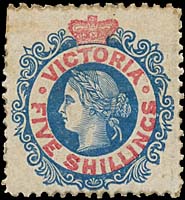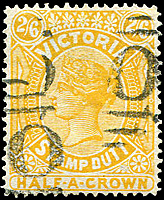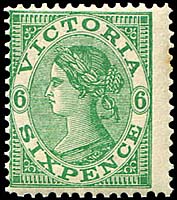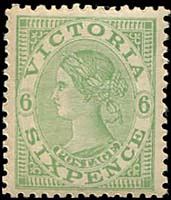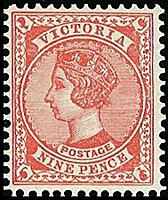The stamps used to pay telegram costs.
- Australia 1901-1988
- New South Wales
- Queensland
- South Australia
- Tasmania
- Victoria
- Western Australia
- International
- Special aspects
There were several stages in Victoria for the use of stamps, including the type of stamps, to pay telegram costs according to the current rates. The stamps used during each of these stages are discussed as follows:
- the authorisation of the use of stamps from 1873;
- the issue of the first telegram form with an embossed stamp image;
- the main stamps used to pay telegram rates 1873 to 1885;
- the main stamps used to pay telegram rates 1885 to 1894;
- the additional 9d stamp required for the new intra-colonial 1895 rate;
- the main stamps used to pay telegram rates 1901 to 1913.
By 1874, postage stamps could be used to pay costs of telegrams in either of two ways:
- payment in lieu of cash;
- by affixing the stamp to the telegram form or to the envelope.
The procedures involved were outlined in the 1874 Rules and Regulations:
 Extract from the 1874 Post Office and Telegraph Department Rules and Regulations: Guidance of Officers and Others in the Telegraph Branch, p. 10. |
The Age of 27 April 1882 carried the following circular issued by the Postmaster-General for Victoria in reference to telegrams forwarded by post:
"The special attention of Postmasters and the public is called to the regulation under which telegraph messages, posted at any post office (not a telegraph office), will be forwarded by first mail to the nearest telegraph office, and be transmitted thence by wire, provided the telegraph charge, in unobliteratcd postage stamps, be affixed to such message.
Telegrams for places within Victoria must have affixed to them postage stamps to the value of at least 1s., or they will be returned. If they bear stamps to that amount, but are insufficiently paid, they will be sent on, and the sum deficit be collected on delivery.
In cases where telegrams are addressed to places beyond the colony, the full charge must be prepaid, or the message will be returned to the sender.
Telegrams, with the necessary stamps affixed, if posted in any letter receiving box or pillar, on reaching the post office, will be, in like manner, handed over to the telegraph branch for transmission. Telegrams posted as above may be written either on a telegraph form or plain paper, and should be enclosed in an envelope (which need not be stamped) legibly endorsed " Telegraphic Message Only." Telegrams addressed to post towns to which there is no telegraphic communication will be transmitted by wire to the telegraph office nearest thereto, and be forwarded thence to destination by first post without any additional charge".
On 1 July 1884, a new regulation was introduced:
"A new regulation, which is of importance to all those who use the telegraph as a means of communication, came into force on Tuesday, 1st inst. It provides that instead of cash being paid for the transmission of telegrahic messages, stamps equal to the cost of the message must be affixed to the form. The stamps may be either fee or duty, and will of course be defaced in the usual way after having been used.
It is anticipated that the operation of this regulation will considerably simplify the work in the telegraph offices throughout the colony, by rendering it unnecessary to keep a book in which every shilling received for telegrams is accounted for".
In the discussion of the 1886 Victorian Budget, the Treasurer (Mr. Giles) noted "that the introduction of the system of payment of telegrams by stamps had proved to be satisfactory to the department. He could not give so satisfactory an account of the sixpenny telegram system as was anticipated. Although business largely increased after the change, the revenue was materially less".
Forms providing for the use of stamps.
The first telegram transmission form to be used in Victoria with an explicit space for affixing postage stamps was that with the 1/- blue indicium. It was first printed in August 1873 (VC-TO-5).
The 1876 form (VC-TO-6) incorporated a space at the top which noted"Payment of the Fee for the transmission of this Telegram may be made either in Cash or in Postage Stamps. When Postage Stamps are used, they must be affixed here". The subsequent form (VC-TO-7) did not have any space for postage stamps so it was not until the last form issued during the Colonial period (VC-TO-9) that the space was again included (and then on all State transmission forms during the Interim period).
The stamps used to pay basic telegram rates.
The stamps shown below are representative of the designs, shades and perforations which were printed. For full details, see the very comprehensive book by Geoff Kellow.
From 1873, the postage stamps on issue in Victoria which could be used to pay basic charges were as follows:
| Basic intra-colonial rate: | ||
| 1/- for 12 words or less; 1d per additional word. |
1/- blue Laureate on blue. (Printings in September 1873, June 1874 and May 1875). |
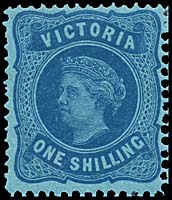 1/- blue Bell on blue paper. Printings from August 1876 to July 1884. |
| Inter-colonial telegrams and higher rate telegrams: | ||
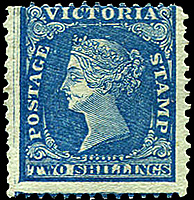 2/- blue or greenish-blue Calvert Woodblock. Printed between 1875 and 1880 on green paper. |
2/- Bell design (1881 to 1884). | |
|
A number of printings on two different papers between 1868 and 1881. |
|
"The postal authorities have issued notices that telegrams may be forwarded by post, through any post-office, not a telegraph-office, without charge for postage, provided the telegraph fee in unobliterated stamps be affixed to the message. Such telegrams may be written either on a telegraph form or on plain paper, and should be enclosed in an unstamped envelope and legibly endorsed — 'Telegraphic message only' ." (Weekly Times 28 April 1883).
The Postage Act of 1883 prescribed that, from 1 January 1885, stamps inscribed STAMP DUTY were the only type which could be used for postal purposes - and therefore (presumably) on telegrams.
| Basic telegram rates: | |||
| Ordinary rate: 6d for 6 words: |
6d blue Naish.
Printed in various shades from 1885 to 1886. |
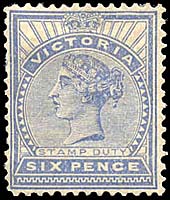 6d blue Fergusson & Mitchell Stamp Duty. Printed in various shades from |
|
| Urgent rate: 1/- for 6 words. (Double the basic rate). |
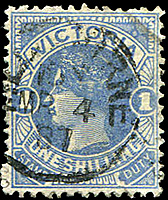 1/- dull blue Naish stamp duty. Printed in 1885 and 1886. |
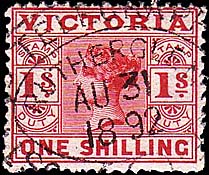 1/- lake Fergusson & Mitchell Stamp Duty. Printed in various shades and papers Has a Rutherglen Belt & Buckle |
|
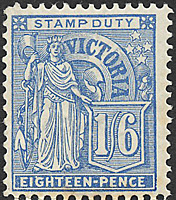 1/6 Naish blue. 1887 & 1889 Stamp Duty. |
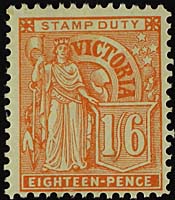 1/6 Naish orange. 1889 & 1893 Stamp Duty. |
||
| Higher value telegrams. | 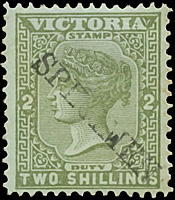 2/- green Naish. 1884-95 Stamp Duty. Overprinted Specimen. |
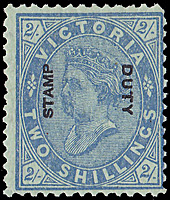 2/- blue Bell with STAMP DUTY overprint. Main printing 1884. |
|
Printed in 10 printings from 1884 to 1897 on 2 papers and shades from brown-orange to yellow. |
|||
| Intra-colonial rate (from 15 May 1895). | ||
| 9d for 9 words. | 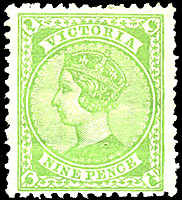 9d Bell in green. Required in 1892 for the inland parcel post rate. Four printings - in 1892, 1893 and two in 1895. |
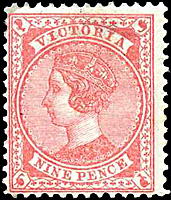 9d Bell in red. No reason known for the change in colour. Ten printings between 1895 and 1900. |
1901-1913 - the Post and Telegraph Rates Act 1902:
The Victorian Stamps Act of 1900 legislated that, as from 30 June 1901, stamps inscribed "Stamp Duty" could not be used for postal purposes - and therefore not used for telegram payments.
As Kellow describes (p. 284-7) stamps available in Victoria were all marked STAMP DUTY and so new stamps had to be printed quickly. For eight denominations, the plates prepared for the 1891 reprints were used as an emergency strategy. The denominations relevant for telegraph use were the 6d, 1/-, 2/- and 5/-. These stamps were printed in late 1900 and are now referred to as the "no postage" issues. As soon as was practicable, new plates were made which included the word "postage" and stamps were printed from these plates from about the middle of 1901.
| Basic ordinary rate for 16 words: | |||
Less than 15 miles:
|
|
Printed in various shades and perforations between July 1901 and May 1905. |
|
9d intrastate rate beyond There was no stamp with a 1/6 denomination valid for postage after the 1/6 Stamp Duty had been invalidated in 1901. Hence the urgent intrastate rate would have been paid with a combination of denominations. |
27 printings between 1901 and 1912. |
||
| 1/- inter-state rate and urgent local rate. | 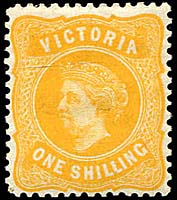 1/- yellow Bell - "no postage". Printed in two types (A and B) in a wide variety of shades on two different papers between June 1901 and September 1905. |
Printed 1905 - 1913. |
|
| 2/- urgent interstate rate:
Double the basic rate |
2/- blue on pink Bell - "no postage". Printed at the end of 1900. |
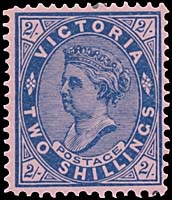 2/- blue on rose Bell - "postage". Printed in various shades (July 1901 to November 1911). |
|
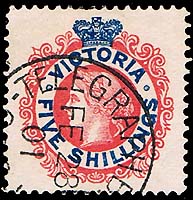 5/- blue and red Laureate - "no postage". Colours reversed from those in the earlier printing about 1870s. Single printing about the end of 1900. Possibly used at TELEGRAPH BRANCH (28 February 1901). |
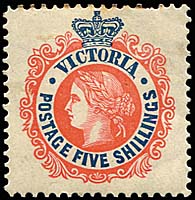 5/- blue and red Laureate - "postage". Printed on two different papers from June 1901 to December 1911. |
|
|
| Higher rates: | ||
Kellow (1990, p.313) notes that the £1 and £2 King Edward VII designs were for "pre-payment of bulk postage ...(but) there must also have been considerable use of both stamps on telegrams. Both usages were internal within the P.O. and the stamps thus used should not have, and in practice rarely did, reach collectors' hands". |
||
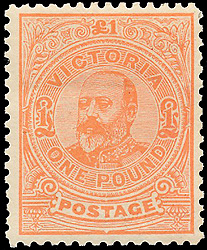 |
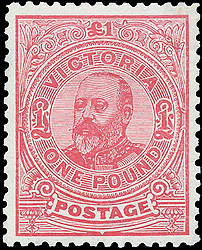 |
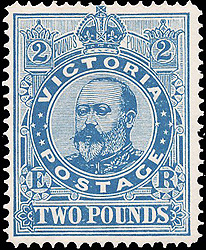 |
£1 salmon King Edward VII (1907). Status sale 290 Lot 1877. |
£1 dull rose Edward VII (1901-10). Status sale 290 Lot 1873. |
£2 dull blue Edward VII (1902-07). Status sale 290 Lot 1876. |
Any system is open to manipulation. The prepayment of telegram charges with stamps was also open to manipulation. A typical example reported in the Bendigo Advertiser on 26 April and 31 May 1895 reveals what manipulation could occur and how it was dealt with.
